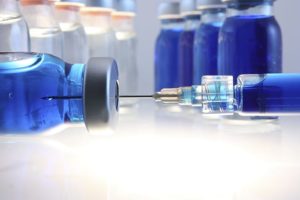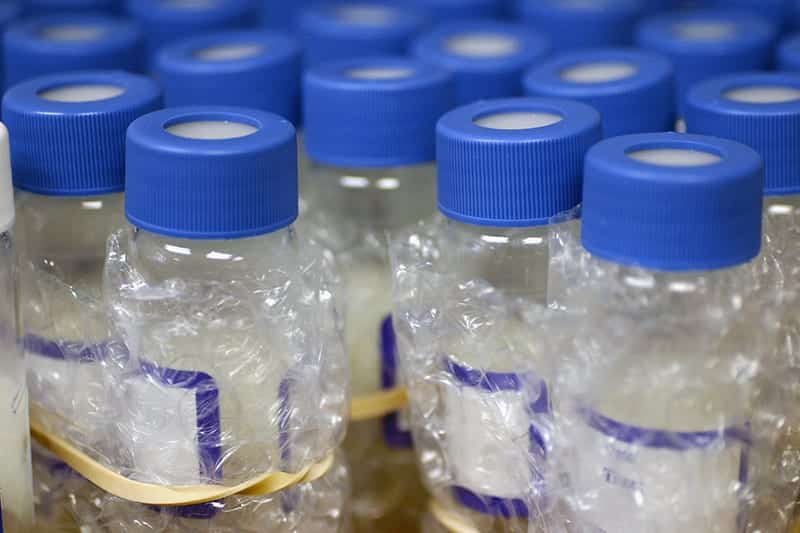Glass vials are a widely used packaging form for parenteral drugs (liquid formulations administered via injection) and have been for many years. Issues with glass delamination and the generation of both visible and subvisible flakes and particulates in marketed drug products have increased significantly within the last several years, leading to numerous recalls. The active pharmaceutical ingredients (APIs)—particularly biologics—in modern therapies are increasingly more complex and require more complex formulations. Both APIs and excipients can interact with and adhere to untreated glass, leading to delamination. The glass vial manufacturers and drug companies have taken several approaches to resolve this issue. Coating the interior of the vials has been one effective solution.
Unfortunately, glass delamination is often undetected until after a drug product has been stored in the glass vial for several months. The only solution at that point is to recall the product. Complicating the situation is that there is no one direct cause of glass delamination, and thus no simple methods for preventing the problem or screening for it. In fact, delamination is the result of chemical attack of the glass surface. This can, in addition to causing the formation of particulates, lead to interactions with the drug product formulation and a decrease in the efficacy of the drug product, as well as possible side effects due to leaching of glass elements into the formulation. Protein adsorption can, for example, lead to a reduced shelf life for sensitive biologic drugs. Metal ion leaching from glass vials can, meanwhile, affect the pH of unbuffered drug formulations, also resulting in reduced stability and possibly efficacy of the biotherapeutic.
The chemical reactions that occur in a glass vial are determined by a number of factors, including the type of glass container, glass type (composition), pH range, drug type, drug formulation (chemistry of the formulation), storage time and temperature, the container manufacturing conditions, and the sterilization process. In addition, slightly changing even a single variable can influence the reactivity of the glass surface. Glass is attacked by water-based systems via ion exchange (acid drug formulations) and dissolution (basic formulations). Ion exchange involves diffusion of water into the glass, leading to leaching—the exchange of hydrogen with alkali ions. Dissolution involves breakdown of the silicate backbone by hydroxide ions. Both mechanisms can result in the formation of a leached layer that can readily detach from the glass surface. Phosphates in drugs formulated in phosphate-based buffer solutions can also react with the glass, leading to the formation of layers that can flake off.
A variety of coatings have been explored
to improve the chemical resistance of glass vials
used for pharmaceutical applications.
Glass composition and manufacturing processes can impact the ability of the glass surface to resist these interactions. All parenteral drugs must be stored in Type 1 glass (USP <660>, EP 3.2.1, ASTM E438) and meet requirements for hydrolytic resistance. Even so, the composition of Type I glasses from different manufacturers can vary significantly. With respect to forming processes, molding involves a one-step, high-temperature process that leads to homogeneous surface chemistry with high alkali/alkaline content, while tubular vials are formed in a two-step process, typically from glass with a higher silicon content. In general, tubular vials are seen as more chemically resistant than molded vials if properly manufactured.
A variety of coatings have been explored to improve the chemical resistance of glass vials used for pharmaceutical applications. Ammonium sulfate is sometimes sprayed into vials prior to the annealing step to reduce the alkalinity of the glass surface. Alternatively, a thin quartz (SiOx) coating is sometimes used to inhibit water diffusion. A chemically uniform SiO2 coating can act as an effective barrier to interactions between biologic APIs and glass surfaces, minimizing protein absorption and increasing shelf life stability. Glass manufacturer SCHOTT has employed plasma impulse chemical vapor deposition (PICVD) to apply several layers of silicon dioxide molecules (at a thickness of 100 to 200 nanometers) to the inside surfaces of glass vials. The thin layers do not affect the dimensions of the pharmaceutical vials but provide an effective diffusion barrier. The coating, which is applied as part of a validated and permanently inspected process, reduces the adsorption of radioactive diagnostic products and proteins and improves the chemical resistance and stability of the packaging material, according to the company. It also reduces the leaching of ions from glass surfaces to levels that are below the detection limit.
 SCHOTT has developed hydrophobic coatings for pharmaceutical vials that are also applied using PICVD. The water-repellant coatings have an extremely smooth surface that are ideal for drug formulations subjected to lyophilization (freeze drying) to extend their shelf lives. Vials with hydrophobic coatings have very homogeneous surfaces and prevent adhesion of the freeze-dried substances to the inside walls of the vials. According to the company, the freeze-dried products have a nice appearance and tend to redissolve more quickly in water. An added benefit of the very smooth surfaces achieved with the hydrophobic coating is that very little of the drug formulation remains in the vial. With conventional pharmaceutical vials, according to SCHOTT, 10–20% of the material sticks to the rough inner-glass surfaces. Drug manufacturers must overfill the vials to ensure delivery of the accurate dosage. When vials with the hydrophobic coating are used, the overfill required is significantly reduced, leading to measurable cost savings.
SCHOTT has developed hydrophobic coatings for pharmaceutical vials that are also applied using PICVD. The water-repellant coatings have an extremely smooth surface that are ideal for drug formulations subjected to lyophilization (freeze drying) to extend their shelf lives. Vials with hydrophobic coatings have very homogeneous surfaces and prevent adhesion of the freeze-dried substances to the inside walls of the vials. According to the company, the freeze-dried products have a nice appearance and tend to redissolve more quickly in water. An added benefit of the very smooth surfaces achieved with the hydrophobic coating is that very little of the drug formulation remains in the vial. With conventional pharmaceutical vials, according to SCHOTT, 10–20% of the material sticks to the rough inner-glass surfaces. Drug manufacturers must overfill the vials to ensure delivery of the accurate dosage. When vials with the hydrophobic coating are used, the overfill required is significantly reduced, leading to measurable cost savings.
Separately, the EU-funded project “Adhesion and cohesion at interfaces in high performance glassy systems” (ADGLASS) developed novel coating technologies to modify forces at interfaces with glass materials to prevent undesired effects. A quantum-based modeling technique was used to develop atomistic simulations of protein adsorption at the interfaces between oxides (silicon dioxide (SiO2) and titanium dioxide (TiO2)) and water as well as the mechanical and chemo-mechanical properties of glassy thin-layer interfaces involved in crack propagation. Experimental studies were performed in conjunction with the theoretical evaluations. The result was the creation of a polyethylene glycol (PEG)-like, anti-adhesive plasma coating for glass vials intended for use in pharmaceutical applications. The PEG-like coating exhibited significantly lower adsorption compared to the evaluated reference vials, greater than 20 times reduction of fibrinogen adsorption under optimum conditions.
